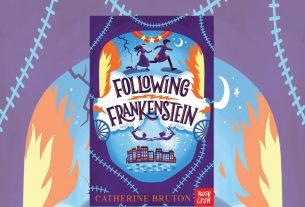This Week’s Word Is “Gender.”
As we move into the 2020s, society is perhaps more open about gender and sexuality than it has ever been. As usual, when reviewing this type of book, I have to state up front that I am a cis-het male and so many of the issues discussed in Seeing Gender don’t and won’t affect me. I can’t fully relate to most of the experiences described in this book.
But as society becomes more open, and my children and their friends grow up and explore their identity, books like Seeing Gender will be invaluable to ensure I can understand and empathize with their thoughts, feelings, and decisions.
What is Seeing Gender?
The book is subtitled “An illustrated Guide to Identity and Expression.” The book’s foreward (by Meredith Taluasan) describes it as being, “the book I would have given my parents and friends when I transitioned.” It is full of helpful information such as why pronouns matter, something that appears to be difficult for people to understand.
“This book is not just for trans of non-binary people but for anyone who has a relationship with gender, which means everyone you know, including you.”
Seeing Gender tries to explain how traditional attitudes towards gender are stifling society. Its primary aims are to educate and liberate. The topic of gender is both nuanced and emotive. Seeing Gender aims to dispassionately explain how and why the traditional two genders model is both erroneous and harmful.
In the introduction, Seeing Gender’s author and illustrator, Iris Gottlieb, is at pains to point out that the book is the representation of a personal journey. Whilst she has done her best to cover as many perspectives as possible, the subject of gender is personal and nuanced, and the written word is a comparatively blunt tool. Gottlieb accepts and apologizes for the fact she may not get everything right. In her introduction, she describes the book as being a number of things.
- An accessible entry point to understanding gender expression.
- A self-education tool that will allow for non-judgemental explanation of your own gender and increased empathy and understanding of others’ experiences.
- A look into how coexisting identities (race, class, gender, sexuality, mental health) relate to gender within larger social systems.
- The story of the author’s gender and how it changed over time, as well as stories from a wide range of people about their gender identities, difficulties, thoughts, and experiences.
It does this using explanations of topics related to gender, as well as histories of key figures, who have fought to express themselves, and key movements. All this is punctuated with key quotes and great looking, helpful illustrations.
The book is broken down into three main sections:
A Good Place to Start.
The baseline of where we are now. A look at gender historically and an introduction to key terms. The importance of pronouns. One page is headed up “What does LGTBQ+ Actually Mean” and ought to be compulsory reading for anybody who doesn’t understand where all the letters have come from. This section also examines physical sex, as opposed to gender, gender dysphoria, gender expression, and the significance of traditional gender roles for enforcing expectations.
Digging Deeper.
This chapter opens with “intersectionality” and deals with differing experiences and attitudes to gender throughout history and around the world. Later on, Digger Deeper asks us to examine our privilege. There’s a particularly interesting section for GeekDads on The Patriarchy that helps put into perspective ways in which male privilege might manifest and what we can do about it. There’s a great follow-up section about Serena Williams that perfectly illustrates male privilege. This then rolls into two powerful sections about “When Black Boys Become Black Men.” which highlights the terrible consequences of privilege and prejudice.
There’s too much in the Digger Deeper section to detail here, but every page contains something interesting about how society is constructed along gendered lines, whether it be “Pink Tax,” “The Feminization of Poverty,” or The Bechdel-Wallace Test.
The final pages of this section comments that whilst there are many terms and categories outlined in the book, nobody should feel defined or confined by them.
My Story.
The final short chapter is about the author’s own journey, starting with how Harry Styles transformed her notions of her “gender, sexuality, body, and fashion.” This chapter is of vital importance. Not only to those people who are undergoing similar questions and journeys but also to people like me who have simply no concept of what it must be like to be subjected to the stress of body dysmorphia. This section goes some way to explaining the difficulty and mental turmoil navigating such a pathway involves.
Learning Never Ends.
Pages 194 and 195, “Learning Never Ends,” possibly bring the most important message of the book.
“Our cultural understanding of gender is always evolving, and the genders of those around us (as well as our own) are always shifting.
It’s Okay to mess up and say the wrong things along the way… When you think you’ve figured it all out, you haven’t.
We all come from different backgrounds, have grown up with different cultural understandings of the world, have different educations, are exposed to different types of people, and come to explore topics at different ages. It can be easy to forget that we learn in diffferent ways and have different interests. Ignorance doesn’t always mean bigotry but an unwillingness to learn is not okay.
This section is massively important to me. Messing up over the sensitive subject of gender is very easy, especially if you’re learning. People will say and do the wrong thing, but helping them understand their mistakes, rather than jumping all over them and making them scared of ever saying anything again, is the way forward. Overly-strong criticism will only stifle the growth of society as a whole. Obviously, the statement in bold is also key here, but accepting that people will make genuine mistakes is vital if sensible conversations about gender (and many, many other things) are going to be normalized and inclusive.
I will note that this section does go on to say that “Sometimes anger is necessary, sometimes disengaging is necessary.”
Why Read Seeing Gender?
Seeing Gender is a personal account of the author’s experience of gender. It presents one person’s point of view and it’s very compelling. I’m not in a position to verify the accuracy of what has been said; as the author herself writes, people with differing perspectives might argue certain points in the book.
Nevertheless, if, like me, you’re a parent wanting to navigate the tricky waters of modern gender attitudes, Seeing Gender is a great place to start. I want to have open and supportive conversations with my children about how they see gender so that they don’t feel confined or unable to express themselves. This book gives them the tools to do just that.
I imagine the book is also great if you’re exploring your own questions about gender. Its’ information is presented in an easy to access fashion and the pictures complement the relaxed, conversational tone of the book.
Seeing Gender is an excellent book about free expression and understanding the multi-faced subject of identity. As society’s conception of gender changes, books like Seeing Gender will be vital in promoting and encouraging understanding of its myriad complexities.
If you’d like to pick up a copy of Seeing Gender you can do so, here in the US and here, in the UK.
Disclosure: I was sent a copy of this book in order to write this review.







